Teeth Whitening
Brighter, lighter, whiter...
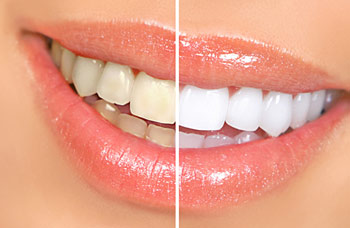
The subconscious impact of a white smile — radiant health, happiness, warmth and invitation are part of the human condition. Beyond personal and social perceptions a contagious smile makes you feel and be perceived as a winner. This phenomenon has been reinforced with the spread of American culture worldwide, where an especially white smile has even been coined a “Hollywood smile.” Social acceptance has created an ever increasing public demand for whiter teeth, considered to be one of the keys to an attractive smile. Where does this perception come from? White teeth are subconsciously associated with youth and virility and are more desirable. Today whiter, brighter, straighter, lighter teeth have become a norm. Moreover dentists have had to create a special shade of “whiter than white” which even in the profession is known as “Hollywood white.”
Whitening to the Rescue
A child's deciduous (baby) teeth are generally whiter than the adult teeth that follow. With age adult teeth often become darker. Discolored teeth cause aesthetic impairment and psychological trauma. Attempts to whiten teeth as a result of tooth discoloration are myriad and date back centuries. Anything and everything from chewing gum to sophisticated dental restorative treatment has been and is being utilized.
Tooth whitening by bleaching is a successful, conservative, relatively inexpensive and safe alternative with few side effects, which for the most part are readily controllable.
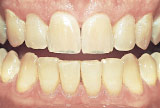 |
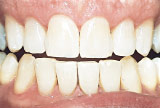 |
| Example of yellowish discoloration caused by aging — lightened by whitening | |
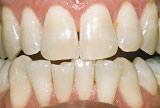 |
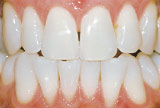 |
| Example of genetically yellowish teeth lightened by whitening | |
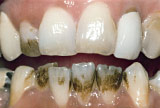 |
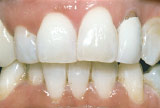 |
| Example of smoking stains removed by polishing and followed by whitening | |
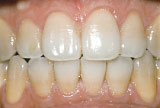 |
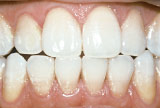 |
| Example of tetracycline antibiotic staining lightened by whitening | |
Whitening of teeth can be achieved by either:
- An external — or “vital” — approach, where vital (living) teeth are bleached by direct contact to the tooth surface
- An internal — or “non-vital” approach (where discoloration is due to pulpal tissue death which has required root canal treatment)
- A third approach, which is a modification of both techniques, can be employed when bleaching vital and non-vital teeth in the same jaw together. This is called “inside/outside” bleaching.
This article will address external whitening by bleaching either professionally applied in the dental office or by home whitening techniques.
Causes of Tooth Discoloration
Tooth discoloration may be described as intrinsic, extrinsic or a combination of both. It varies in appearance, cause, severity, position and adherence to the teeth. Intrinsic (internal) tooth discoloration is caused by changes in the structure of enamel or dentine or by incorporation of chromogenic (color generating) material into tooth tissue, either during tooth formation or after eruption. Wear of teeth, thickening of dentin due to aging or as a consequence of pulp inflammation affect the light-transmitting properties of enamel and dentin, resulting in a gradual discoloration.
Aging results in changes in the mineral structure of the tooth; the enamel, the outer covering loses its beautiful and youthful translucency, becoming less porous; and the underlying dentin, which forms the body of the teeth thickens and becomes more yellow. Intrinsic discoloration is also caused by exposure to high levels of fluoride, tetracycline antibiotic administration during childhood, inherited developmental disorders and jaundice in childhood. After eruption, tooth decay, restorations, pulp death (root canal problems) and trauma to developing teeth, are the main causes of intrinsic discoloration.
Extrinsic staining mainly results from dietary factors and smoking; foods containing tannins such as red wine, coffee and tea can give rise to extrinsic stain. Carotenes, pigments in oranges and carrots, and tobacco use, whether it is smoking or chewing, also give rise to extrinsic stain.




